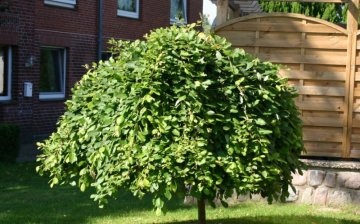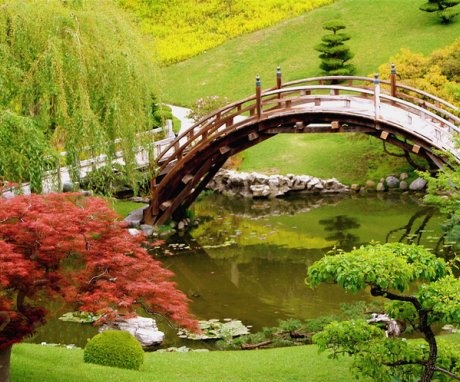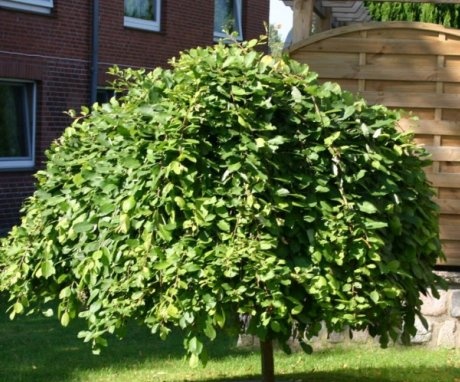Garden Ideas - Ornamental Trees: Species and Their Growing
Ornamental trees do not bear fruit. But they give joy with their beauty. You just need to choose the right plants and skillfully arrange them on the site.
Content:
- Garden style
- Garden layout rules
- Growing ornamental trees
- Varieties of decorative trees for the garden
Garden style
The garden has been created for more than one year. First, trees are planted, then they are placed between them shrubs, perennial flowers. We can change one-year-olds every year. Ornamental trees remain the basis of the composition for many years. Therefore, their selection and landing site must be taken responsibly.
First, they are determined with the style of the future garden. He can be:
- A regular garden is distinguished by even rows of trees, straight paths, regular geometric shapes of tree crowns. To do this, they will need to be cut frequently. In such a garden, hedges from different breeds of different heights.
- The landscape garden should look like all the trees and shrubs have grown here on their own. But in order to get such an effect, you need to carefully consider how to plant trees. Their choice for this type of garden is practically unlimited.
Usually, the garden is not laid out from scratch, and there are already some trees on the territory. Consider whether they will fit into the composition of the future garden, if you see them there as the basis of the structure. If not, clean up without regret. If you leave these trees, then all the others are planted taking into account the existing ones.
When placing decorative trees in the landscape design of the garden, you need to take into account the size of their future crown.
Planted too close will interfere with each other. This will lead to curvature of the trunks and crown formation irregular shape. Large trees take a long time to grow. Their crown has been forming for several years, or even decades. So that the garden does not look naked, the space that the crown will occupy in the future is filled with various shrubs.
When choosing trees for a garden, first of all, its area is taken into account. The larger the plot, the higher the trees there can be planted. An exception may be an already growing tree with a beautiful crown. It can be left even in a small area.
Garden layout rules
To create a beautiful garden, you need to pick up beautiful trees. But it is even more important to successfully arrange them on the site. There are rules here. When choosing trees, take into account:
- Appearance
- Growth rate
- Soil composition
- Climate
- Groundwater location
- The shape of the landscape
Tall trees are not planted in one place. But placing them evenly throughout the garden, after a certain number of meters, is also not worth it. Medium-sized trees can be planted in scenic groups. They look beautiful if they consist of plants of different heights, crown shapes and leaf colors. Of course, in the color scheme, one must observe the measure, from such a composition should not ripple in the eyes.
When arranging trees in groups, take into account that the lower they are, the more they are needed in a given place.
By creating group landing, remember that a person can fix attention simultaneously on one dominant, dominant group, and no more than three subordinates to it. But the garden will be viewed from different angles. And, most likely, from a different point of view, the effect will be slightly different.Another group will be dominant. Therefore, it should also have its own flavor. It is more difficult to create a beautiful composition in a small garden. Here it will not be possible to hide the miscalculations behind a large number of trees. But it is easier to decide on the dominant plants.
Living hedges can be used both as independent elements and as a background for picturesque compositions. They are created from plants that have a constant crown shape with clear contours.
You can plant in the garden:
- Deciduous evergreen. Deciduous evergreens have the advantage of remaining green while other trees shed their leaves. These are mainly shrubs: rhododendrons, mahonia, holly, cherry laurel, rugose viburnum.
- Deciduous, shedding leaves. Among deciduous trees, fast-growing ones are preferred. rowan, different types birches, low maples (silver and Manchu). They do not freeze in winter, they look great. If the garden is large, you can leave alone standing oak on its territory, chestnut or Canadian maple.
- Coniferous trees. Conifers are now very popular, especially varieties with a rounded crown. Among conifers, pine, spruce, thuja, juniper, cypress trees are popular and look good in plantings. They are unpretentious in care, take root well.
- Small fruit trees can also beautify the garden. These are small-fruited apple trees, which delight the eye with flowers in spring, and colorful leaves in autumn.
- Many people want to decorate their garden with exotic plants. But not all of them take root in these climatic conditions. Therefore, before buying such, you need to consult with landscape design specialists or experienced gardeners.
Growing ornamental trees
Ornamental trees can be planted in autumn and summer. You just need to wait for the growth period to end. Visually, it can be determined by the amount of foliage on the seedling. If there is less than half of it left, you can transplant:
- In the fall, in October or November, it is better to replant ornamental trees because this significantly reduces the amount watering... Enough ten times, every other day. In the spring, you need to water it daily until rooting, and then periodically until autumn.
- But in winter, transplanted trees are more prone to frost, they can be damaged by rodents.
It is better to buy trees with a closed root system (in containers). You need to pay attention to whether it has taken root, or whether it was planted just before the sale. A lump of earth should not crumble, it is all permeated with roots and has the shape of a container. These plants can be planted all summer long, avoiding particularly hot and dry days.
Young trees need to be watered regularly, especially during dry periods.
So that the soil around the trunks does not dry out, mulch near-trunk circles. Use freshly cut grass, straw. But with heavy and regular rains, you need to make sure that the mulch does not interfere with the ventilation of the air near the roots. During such periods, it is better to put it aside for a while.
If you want to create a beautiful garden without much hassle, carefully study the tree growing conditions that you have outlined for yourself. If you saw that the type soil for some plant does not correspond to the one you have, it is better not to buy it. After all, changing its composition is not so easy. It is necessary to add the appropriate substances and elements, for example, lime. There is a wide selection of plants that are best suited for your site. Ornamental trees respond well to fertilizer... Its composition must be clarified when buying trees. Many of them grow well without constant feeding.
Varieties of decorative trees for the garden
Among the varieties of ornamental trees, one can name red-leaved peach, bignoniform catalpa, willows of Matsudan, Tortuosa, Kilmarnock, Syrian hibiscus, Variegata sod, birch.
Description of varieties:
- The red-leaved peach does not bear fruit, but is valued for the beautiful burgundy leaves that it inherited from Pissardi's cherry plum. It is she who is the ancestor of the red-leaved peach. The plant is grown in groups where its leaves are set off by green trees, or singly.
- Catalpa bignoniform is beautiful during flowering... Her flowers are shaped bells collected in brushes. Large ovoid leaves and long pod-shaped fruits up to 50 cm adorn the plant in summer. They do not turn yellow in autumn. The plant is not very hardy. Therefore, young plants are sheltered for the winter. It grows well on fertile, slightly acidic soils. Requires a lot of light, moisture. It begins to bloom from the age of five. Grows up to 100 years. Care consists of weeding weeds, regular watering once a week. They are fed with rotted manure.
- The willows of Matsudana and Tortuosa are very decorative, with winding ropes. The willow of Matsudan has olive-colored ascending branches. The leaves are twisted. It is beautiful in summer and winter, when its beautiful branches become visible. They are planted both singly and in groups. It can freeze under severe frosts, but it quickly recovers in spring. Iwu Matsudana can be propagated cuttings.
- Willow Tortuosa differs from willow Matsudan in a dense crown, twisting branches, yellow or reddish. Looks good near artificial or natural reservoirs.
- Goat willow Kilmarnock is a small tree grafted on a trunk up to 2 m high. Leaves are oval, pubescent below. In the spring they turn yellow. Fragrant earrings adorn it before the leaves bloom. By pruning, you can form an original crown. It tolerates frost well, can grow in partial shade. Loves moist soil. But from excess water, its root system can rot.
- Syrian hibiscus is not very hardy. It features huge (7 cm) bright flowers of various colors, from white to red and purple. Grows well in the southern regions. There you can grow varieties with double flowers. In the more northern ones, it is better to use hibiscus with simple flowers. They are planted in the warmest and most protected areas of the garden.
- Derain Variegata is appreciated for its original color of leaves. In winter, it attracts with its brightly colored branches, from yellow to burgundy. One of the types of turf is dogwood... It is grown as a shrub or tree. Loves calcareous soils. Grows up to 400 years old.
- White birch trees are well known and widespread. But besides them, there are many interesting species of this tree. Among them are woolly birches and Erman, whose rounded earrings are directed upwards. Species with egg-shaped leaves (ribbed, cherry, Schmidt). Almost all of them are frost-resistant and light-requiring. They grow on any light soils. They do not like soil compaction around the trunk.
More information can be found in the video.

















I have a fairly large personal plot, about 12 acres. Along the perimeter, almost all of it was planted with ornamental plants, but not those that do not give fruit, but dwarf apple trees, viburnum, etc. Both beautiful and useful.